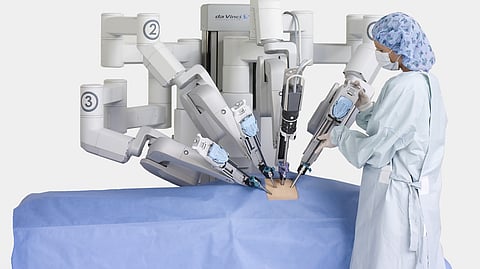

In a major advancement for cancer care in India, a new multicentre study has confirmed that robotic-assisted surgery using ‘da Vinci’ technology offers significantly safer and more efficient outcomes for patients with endometrial cancer. The procedure is linked to lower complication rates, faster recovery, shorter hospital stays, and fewer conversions to open surgery, according to findings published in Cureus by the Indian Gynecologic-Onco Study Group.
The study represents one of the most comprehensive real-world evaluations of endometrial cancer surgeries in India and underscores the role of advanced robotic technology in improving surgical safety and oncologic consistency.
Endometrial cancer, which originates in the inner lining of the uterus (endometrium), is increasingly diagnosed among women, particularly in pre- and post-menopausal age groups.
Conducted in collaboration with Intuitive Surgical, the U.S.-based medical device company behind the da Vinci system, the study brought together surgeons from India’s leading institutions — including the Rajiv Gandhi Cancer Institute and Research Centre, Tata Medical Centre, Aster, Apollo Hospitals, Narayana Health, Fortis, Amrita Institute of Medical Sciences, KDH Group, and Medica.
Analysing data from over 2,000 patients with Stage-I endometrial cancer treated across 13 hospitals, researchers compared outcomes from open surgery, conventional laparoscopy, and robotic-assisted surgery.
The results were clear — robotic-assisted surgery outperformed other approaches across key surgical parameters. It was associated with lower complication rates, shorter hospital stays, less blood loss, fewer transfusions, and fewer conversions to open surgery compared to laparoscopy.
Notably, operative times were reduced by about 50 minutes compared to laparoscopy and 20 minutes compared to open surgery, resulting in shorter anaesthesia exposure and quicker recovery from the operation theatre.
The study also reported that robotic-assisted surgery had a lower rate of positive surgical margins, reducing the risk of cancer recurrence. The enhanced 3D visualisation and precision of the da Vinci system enabled cancer clearance comparable to open surgery, but with less pain and faster recovery.
Robotics also facilitated more comprehensive disease staging, including lymph node dissection, crucial for evaluating disease spread and planning subsequent treatment. Furthermore, patients who underwent robotic-assisted procedures could begin post-operative chemotherapy nearly a week earlier than laparoscopy patients and around four days earlier than those who had open surgery — a factor linked to improved long-term outcomes.
“The findings help address a long-standing gap in localised data. Until now, Indian clinicians largely relied on international studies to guide surgical decisions in gynaecologic oncology,” said Dr Vandana Jain from the Rajiv Gandhi Cancer Institute and Research Centre, New Delhi.
Dr Jain, a leading contributor to the study, added,
“This new multicentre evidence offers a more nuanced picture of how these approaches perform in real-world Indian settings and could inform both clinical pathways and institutional adoption strategies going forward.”
The study further highlights how robotic-assisted surgery can be particularly beneficial for older or obese women with co-existing health conditions, where reducing complications and recovery time is critical.
“Robotic systems like ‘da Vinci’ offer greater access and precision, especially in narrow or anatomically challenging spaces, which makes them particularly effective. They allow us to remove the cancer tissues thoroughly while reducing the physical impact of surgery,” Dr Jain explained.
“With robotic-assisted procedures, we have been able to lower the complication rates and shorten hospital stays without compromising oncologic safety. These are meaningful advantages for both patients and the surgical teams working to give them the best possible care,” she said.
Dr Jaydip Bhaumik from the Tata Medical Centre, Kolkata, another contributor, stressed the importance of this local data:
“This kind of India-specific evidence is critical. It helps hospitals assess whether newer technologies like robotic-assisted surgery are translating into tangible benefits in our patient population.”
“It also gives the surgeons a clear reference point on where each approach stands in terms of safety, efficacy, and post-operative recovery,” he added.
As endometrial cancer cases rise across India, especially among pre- and post-menopausal women, experts believe that studies like this are both timely and transformative. For women with early-stage disease, robotic-assisted surgery emerges as a safe, precise, and effective option, offering faster recovery and better staging accuracy — empowering surgeons to deliver optimal treatment tailored to each patient.